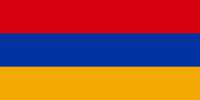List of Intangible Cultural Heritage elements in Armenia
 From Wikipedia the free encyclopedia
From Wikipedia the free encyclopedia

The United Nations Educational, Scientific and Cultural Organisation (UNESCO) intangible cultural heritage elements are the non-physical traditions and practices performed by a people. As part of a country's cultural heritage, they include celebrations, festivals, performances, oral traditions, music, and the making of handicrafts.[1] The "intangible cultural heritage" is defined by the Convention for the Safeguarding of Intangible Cultural Heritage, drafted in 2003[2] and took effect in 2006.[3] Inscription of new heritage elements on the UNESCO Intangible Cultural Heritage Lists is determined by the Intergovernmental Committee for the Safeguarding of Intangible Cultural Heritage, an organisation established by the convention.[4] Armenia ratified the convention on 18 May 2006.
Intangible Cultural Heritage elements[edit]
Representative List[edit]
| Name | Image | Year inscribed | No. | Description |
|---|---|---|---|---|
| Duduk and its music |  | 2008 | 00092 | The duduk is a double reed woodwind instrument made of apricot wood. It is commonly played in pairs: while the first player plays the melody, the second plays a steady drone called dum, and the sound of the two instruments together creates a richer, more haunting sound. |
| Armenian cross-stones art. Symbolism and craftsmanship of Khachkars |  | 2010 | 00434 | A khachkar is a carved, memorial stele bearing a cross, and often with additional motifs such as rosettes, interlaces, and botanical motifs. |
| Performance of the Armenian epic of 'Daredevils of Sassoun' or 'David of Sassoun' |  | 2012 | 00743 | Daredevils of Sassoun is a heroic epic poem in four cycles (parts), with its main hero and story better known as David of Sassoun, which is the story of one of the four parts. |
| Lavash, the preparation, meaning and appearance of traditional bread as an expression of culture in Armenia |  | 2014 | 00985 | Lavash is a thin flatbread usually leavened, traditionally baked in a tandoor (tonir or tanoor) or on a sajj. |
| Kochari, traditional group dance |  | 2017 | 01295 | Kochari is a folk dance originating in the Armenian Highlands. |
| Armenian letter art and its cultural expressions |  | 2019 | 01513 | |
| Pilgrimage to the St. Thaddeus Apostle Monastery +[a] |  | 2020 | 01571 | |
| Tradition of blacksmithing in Gyumri | 2023 | 01967 | Blacksmithing, or the creation and repair of iron objects, has played a central role in the local identity of the city of Gyumri. |
See also[edit]
Notes[edit]
- ^ Shared with Iran.
References[edit]
- ^ "What is Intangible Cultural Heritage?". UNESCO Intangible Cultural Heritage. Retrieved 13 January 2024.
- ^ "Text of the Convention for the Safeguarding of Intangible Cultural Heritage". UNESCO Intangible Cultural Heritage. Retrieved 13 January 2024.
- ^ "The States Parties to the Convention for the Safeguarding of the Intangible Cultural Heritage (2003)". UNESCO Intangible Cultural Heritage. Retrieved 13 January 2024.
- ^ "Functions of the Intergovernmental Committee for the Safeguarding of Intangible Cultural Heritage". UNESCO Intangible Cultural Heritage. Retrieved 13 January 2024.
External links[edit]
- UNESCO Intangible Cultural Heritage: Official site
- UNESCO Intangible Cultural Heritage in Armenia: Official site


